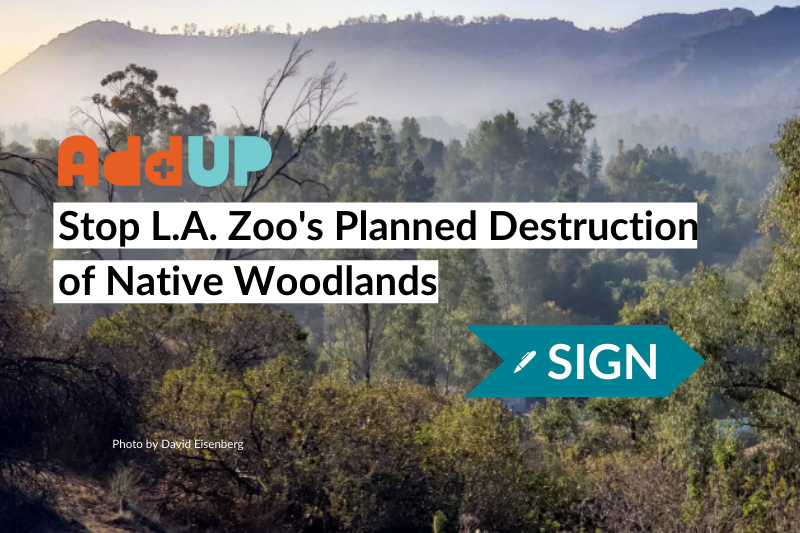Sierra Club Angeles Chapter is calling on the Mayor and City Council to Stop L.A. Zoo's planned destruction of native woodlands. A $650 million LA Zoo expansion would make room for modern animal habitats and veterinary support facilities, but could impact 227 protected native trees like Southern California Black Walnut, Toyons, Coast Live Oak, and other native shrubs. Instead club leaders are asking Angelenos to support the environmentally superior Alternative 1 in the Zoo Vision Plan, which preserves 23 acres of native woodlands.

On the Los Angeles Zoo’s website, the organization states that one of its goals is to “shape a better future for wildlife, humans, and our shared world.” However, recent plans paint this venerable family attraction in a much different light.
The Zoo recently proposed a “Vision Plan” that includes installing more retail stores, constructing a Yosemite lodge-style California Center to look over a 25,000 square-foot vineyard, and blasting a 60-foot-deep canyon for rock climbing. Ostensibly these new plans will provide “a regional gateway to nature” and enhance educational outreach about species and habitat preservation. Ostensibly.
The Verdugo Hills Group (in conjunction with the Friends of Griffith Park, California Native Plant Society, and members of the Central Group, Crescenta Valley Group, Santa Clarita Group, and Angeles Chapter) has spearheaded a campaign
to stop the LA Zoo’s plans for expansion.
The main reason for the groups’ protest lies in the fact that to realize the Zoo’s plans, “23 acres of native woodlands must be destroyed”, a habitat that “contains 120 coast live oaks, 60 toyons, 22 California black walnut trees and stands of federal and state-listed endangered shrubs.” Further, the Verdugo Hills Group emphasizes that the 23 acres planned to be destroyed “host 227 trees listed under L.A. City's Protected Tree Ordinance.” This stands in stark contrast to federal and state approval of the 30 x 30 campaign, a plan to protect 30 percent of American wildlands and waters by 2030. Approval of the zoo’s “Vision Plan” would serve as little more than a slap in the face to these environmental promises.
Indeed, the Zoo’s efforts are much better suited to, as Cynthia Robin Smith of the Pomona Valley Sierra Club Task Force writes, “recognizing and supporting the remarkable diversity existing in their backyard.” With fanciful vineyards and rock-climbing walls, the Zoo’s plans seem less like a means to garner public appreciation for wildlife than an opportunity to create yet another Los Angeles amusement park (see: Disneyland, SeaWorld, Universal Studios). The Zoo also has its eyes on the future revenue stream from the 2028 Los Angeles Olympics.
“We definitely had the Olympics in mind when we were developing this plan,” said Denise Verrett, the Zoo’s director in
an interview by the Los Angeles Times. “The Vision Plan is a move towards “placing the LA Zoo at the best-zoos-in-the-nation lists.”
There is no need for a nature-themed Disneyland. And with the environmental damage expected as a consequence of the 2028 Olympics (the 2016 Rio Games produced a
terrifying 17,000 tonnes of waste and consumed 29,500 Gigawatts of electricity, mostly from non-renewables), it is critical that Los Angeles’s diminishing wild places are preserved.
“[The LA Zoo] sees the Olympics as a cash cow”, said David Eisenberg, co-author of
the AddUP campaign.
The 23 acres the Zoo plans to destroy are home to a swath of native plant species and “every species of hawk and owl in LA County”, further endangering the biodiversity that makes Southern California one of the
36 “Biodiversity Hotspots” in the world, according to the Critical Ecosystem Partnership Fund. This classification is administered under two strict criteria: the region must “contain at least 1500 species of vascular plants found nowhere else on Earth” and must “have lost 70 percent of its primary native vegetation.”
“Griffith Park was donated as a space for anyone to enjoy. But people only look at this place with developing in mind”, said David Eisenberg. “[The Vision Plan] has nothing to do with the care of the animals. It is all about the visitors’ experience.”
Los Angeles has already lost approximately 75% of its original habitat. Let’s keep everything else, even if it’s just 25%, wild.

